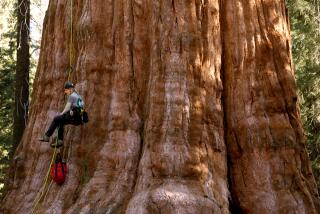Gene Yields Data From 20 Million Years Ago : Evolution: The material from a magnolia tree was decoded by UC Riverside researchers.
- Share via
UC Riverside researchers have decoded a gene from a 20-million-year-old magnolia tree, obtaining the first direct evidence about the nature of life in that ancient era, a finding that may shed new light on evolution on Earth, they report today in the journal Nature.
The oldest material decoded previously was only 7,000 years old.
The new data provides the first precise measurement of the rate at which changes in DNA occur during evolution. The new data should have dramatic implications for the ongoing, and often contentious, debates about when various species diverged from a common ancestor and when the first modern humans emerged.
The magnolia leaf that the researchers used came from a unique fossil site at Clarkia in the western foothills of Idaho, where genetic material from a broad variety of species has been preserved intact. Application of the technique to other specimens from the site, the researchers said, could provide a wealth of information about the evolution of other species.
“This research could open a whole new field of molecular paleobotany,” said UC Riverside plant geneticist Michael T. Clegg. “It will reveal new insights into the relationships between modern life forms and their ancient ancestors.”
“What’s most important is that it indeed shows that we can get genetic material out of fossils, at least when they are preserved under the right conditions, and therefore we can get a direct handle on the rates at which DNA has changed,” said paleontologist James Edwards of the National Science Foundation. “That’s really exciting.”
The magnolia leaf the researchers used was not a conventional mineralized fossil, such as those found in most fossil deposits. Rather, it was a so-called “plant leaf compression” containing almost all of the original leaf tissue that formed under unusual conditions.
The fossils were preserved at the bottom of a lake that formed when volcanic lava dammed a valley in the hilly region. Leaves and other materials settled to the bottom, where the stagnant, deep water was devoid of oxygen. Sediments filled the lake over a period of 750 to 1,000 years.
“The deposits formed in an exceptionally cold, dark environment,” said geologist Charles J. Smiley of the University of Idaho, a co-author of the paper and manager of the Clarkia site. “They were covered with silt and sealed in primeval water. Since there was no oxygen or bacteria present, there was little actual degradation of the leaf tissue over the course of millions of years.”
Although the leaf was remarkably well-preserved, it still contained only an extremely small amount of deoxyribonucleic acid (DNA, the blueprint of life). To overcome that problem, Clegg and graduate student Edward M. Golenberg used a new technique called polymerase chain reaction to make millions of copies of the DNA.
Polymerase chain reaction, developed in the 1980s by researchers at Cetus Corp. in Emeryville, allows researchers to use chemical reactions to replicate DNA much faster than can be achieved with conventional genetic engineering techniques. Its availability has greatly accelerated the pace of research in virtually all areas of genetics.
Once the amount of DNA had been multiplied, Clegg and Golenberg used conventional techniques to identify the sequence--the order in which individual nucleic acids occurred--of the ancient leaf’s gene that codes for a protein required for photosynthesis, the process by which plants convert sunlight and carbon dioxide into sugars.
They chose this gene because they already knew its sequence in a variety of plant and tree species. “Also, this photosynthesis gene is not present in fungi or bacteria, so we could rule out contamination,” Clegg said.
By comparing the gene from the ancient magnolia to its modern counterpart, the researchers found that evolution took place at the rate of one mutational event, or change in DNA sequence, every million years. This information provides them with a kind of “molecular clock” that will allow them to more precisely date when various plant species diverged from common ancestors, thereby providing a kind of “family tree” for botanical species.
In fact, the use of such molecular clocks has proved to be one of the most promising tools of paleontology in the 1980s, but their use has been limited because researchers have been able only to make educated guesses at mutational rates.
Application of Clegg’s technique to animals could give much more precise values for the clock, and thereby make researchers more confident of the timing of evolutionary events.
Such applications now seem possible. “There are literally millions of leaves, many insects, three or four different kinds of fish, and also microscopic organisms” at the Clarkia site, Smiley said. While Clegg is concentrating on genes from magnolia and other plants, he expects other researchers to quickly begin studying the other organisms.






